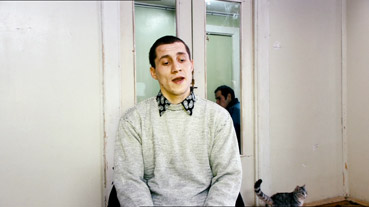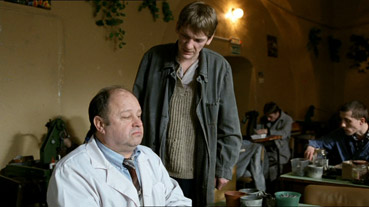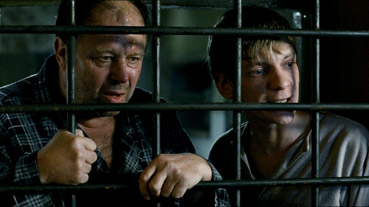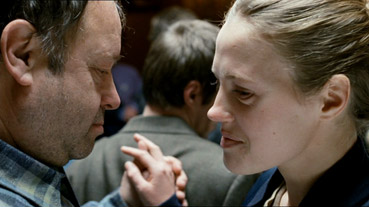"You can hold yourself back from the sufferings of the
world . . . but perhaps precisely this holding back is the
only suffering that you might have been able to avoid." |
Franz Kafka |
"Our society is run by insane people for insane objectives,
but I'm liable to be put away as insane for saying that." |
John Lennon |
Palata No 6/Ward No 6 is an engrossing adaptation of Chekhov's timeless tale of institutional corruption and existential crisis. The plot revolves around the central character of Dr. Andrei Yefimitch Ragin (Vladimir Ilin), the depressed overseer of a provincial mental hospital who gradually withdraws into himself, books and alcohol. Already a man on the verge a nervous breakdown, Ragin is, ultimately, outmaneuvered by a Machiavellian colleague, Dr. Khobotov (Yevgeny Stychkin), and winds up as an inmate in the institution he once ran. Co-directors Alexander Goronvsky and Karen Shakhnazarov rework this story with considerable panance, retaining the essence of the tale while dispensing with its structure. Shakhnazarov, the driving force behind the project, is a gifted filmmaker and Director of the legendary Mosfilms studios. On the evidence of this film, he has highly developed literary sensibilities too; Chekhov's text is re-presented verbatim but it is also rearranged, reimagined and radically deconstructed.

Soviet cinema, of course, gave us some of the most dazzlingly original films ever made. Shakhnazarov presides over studios that produced masterpieces of film history such as Eisenstein's Broyenosyets Potyomkin/Battleship Potemkin (1925), Mikhail Kalatozov's Letiat zhuravli/The Cranes are Flying (1958) and Larisa Shapitko's Voskhozhdeniye/The Ascent (1975). But, particularly in the 60s, Soviet cinema also specialised in painstakingly accurate adaptations of the classic texts of Russian literature. In films such as Iosif Kheifits's adaptation of Chekhov's Dama s sobachkoy/The Lady with the Dog (1960), Sergei Bondarchuk's adaptation of Tolstoy's Voyna i mir/War and Peace (1965), and Kirill Lavrov's adaptation of Dostoevsky's Brat'ya Karamazovy/The Brothers Karamazov (1969), the emphasis was on fidelity to the text. That tradition continued through to Vladimir Bortko's adaptation of Bulgakov's Sobach'e serdtse/The Heart of a Dog (1988), a hugely popular masterpiece of late-Soviet cinema. When the Russian film industry collapsed after the dissolution of the U.S.S.R, the tradition came to an abrupt end. Fortunately, Ward No 6 demonstrates that there's life in Russian cinema yet, and this is no mere painting-by-numbers adaptation.
Shakhnazarov transfers Chekhov's story from the late 19th to the early 21st Century, and blurs the divide between documentary and fiction. Shot in a working psychiatric hospital on the site of an ancient monastery, the film features actual inmates as bit-part actors and takes the form of a 'documentary' investigation into Ragin. It tells his story through a series of direct-to-camera interviews with his colleagues, patients and acquaintances. Professional actors play the principal roles but they move among the inmates throughout the film. Imagine Milos Foreman's 1975 classic One Flew Over the Cuckoo's Nest filmed under such circumstances, with Jack Nicholson grinning sardonically, as the patients potter about in the background, casting inquisitive glances his way. Ward No 6 is disconcerting but it never feels false. Documentary devices such as hand-held camerawork; silent, grainy 'home movie' footage; audiotape recordings and the talking-head interviews are deployed to raise complex questions about the reliability of witnesses, memory, conventional definitions of insanity, and our own perceptions.

The film opens with a series of straightforwardly documentary interviews with emotionally damaged hospital inmates. Their heartrending accounts of parental rejection and orphanage upbringings remind us of the well-established links between childhood trauma and psychological and behavioural problems in adult life. These moving interviews are followed, first by the credits, then by an elegantly shot sequence delineating the pre-history of the monastery and grounding the story in the Russian past. In a particularly successful reordering of Chekhov's story, one of the closing lines of the book ("A herd of deer, extraordinarily beautiful and graceful, of which he had been reading the day before, ran by him.") is recreated visually and inserted into this introductory sequence.
After this isolated moment of cinematic classicism the action returns to the hospital, to the present day and to the film's peculiar version of reality. The aesthetics of documentary pastiche are, henceforth, maintained throughout. There are further fly-on-the-wall interviews of inmates, but they are now mediated by Dr. Khobotov. Patients talk of hearing voices and reveal their delusions: one calmly tells us that his former neighbours tried to irradiate him; another believes that Yuri Andropov ordered him to assassinate John Lennon. During this second series of interviews Khobotov introduces us to another a key character, Ivan Dmitritch Gromov (brilliantly played by Aleksei Vertkov, who bears a striking resemblance to a young Malcolm McDowell). This scene is typical of the way the film cuts back and forth between reality and invention, as it moves across time through use of flashbacks. The effect is unsettling, repeatedly prompting the question, 'Am I watching actors or inmates, inmates as actors, or actors as inmates'?

The 'documentary crew' next moves on from Gromov to Dr. Ragin. Disgusted with himself and the world, he has retreated into a shell of self-imposed silence. He is clearly a broken man. It is a tried-and-tested technique for the creation of narrative tension: introduce a damaged character, then drip-feed the audience clues as to what befell him. We gradually learn that Ragin's existential crisis is linked to his lack of vocational pride (his father forced him into medicine against his wishes), exacerbated by his emotional and intellectual isolation (he has just one friend), and rooted in a nihilistic, fatalistic philosophy (we inhabit a godless universe, fate is all, resistance is futile, alleviation of suffering is senseless.).
Ragin's one friend is the amiable but boorish local postmaster, Mikhail Averianych (Aleksandr Pankratov-Chyornyy). Ragin rails against the limitations of provincial life whenever Averianych visits him, but his friend's own limitations become increasingly obvious to Ragin and the friendship finally fractures after the two take a disastrous holiday together. It is not just companionship the reflective Ragin craves; it is the company of somebody on his philosophical wavelength. He turns from his dull-witted friend, Averianych, to his quick-witted patient, Gromov, for meaningful conversation. It proves to be his undoing.
Gromov has a pronounced persecution complex but is otherwise sane, intelligent and articulate. He accuses Ragin of self-indulgence and of having lived a pampered life, then dismantles the rationalisations the doctor has concocted to salve his conscience and justify his inaction. Indifferent and incompetent Ragin may be, but he values ideas and Gromov's attacks hit home, hastening the end of Ragin's journey into self-awareness and despair. There is more in Chekhov's story and Shakhnazarov's film than is suggested by sound-bite synopses about "one man's descent into madness'.

To use the language of today about a novel of yesterday, as the film does, we might say that there is an air of the counter-cultural dropout about Ragin. Chekhov stresses Ragin's freethinking atheism; Shakhnazarov sends us smoke signals through the posters on Ragin's walls. His pin-ups are The Beatles, Jim Morrison, Orson Welles and, most significantly in the Russian context, Vladimir Vysotsky. Ordinary Russians have traditionally esteemed their artists and their literary culture much more highly than we have, and Vystosky could claim to be the most popular Russian of his generation. He had no equivalent in the 'free Vest' (imagine a composite of John Lennon and George Bressens, Victor Jara and Dylan Thomas, Jacques Brel and Brendan Behan). Shakhnazarov's homage to Vysotksy is clever and calculated; it is a wink to Russians, hinting at Ragin's respect for anti-authoritarian integrity and calling forth sympathy for him.
Ward No 6 is taut and, with a running time of just 83 minutes, aptly to the point for an adaptation of a short story. Unfortunately, the two cardinal Chekhovian virtues of subtlety and depth become sacrificial victims of the film's brevity. This failing is particularly evident in its handling of the exchanges between Gromov and Ragin, which are crucial to our understanding of both Ragin and Chekhov. In the absence of more detailed coverage of their clash of ideas, we are largely left guessing at the reasons for Ragin's breakdown. The ensuing sense of mystery accidentally adds something to the atmosphere of the film, just as certain mysteries of Chekhov's life add to the atmosphere of his books. There are certainly mysteries aplenty to consider in Chekhov's life.
In 1890, already established as a doctor but still just a promising writer, Chekhov embarked on an arduous trans-Siberian expedition to the brutal penal colony of Sakharin. The journey took two and a half months and may have had fatal consequences for his physical health. He worked at Sakharin as a self-appointed public health inspector, surveying the conditions of the incarcerated inmates. We can only guess why he went there. Was he in flight from boredom, like Ragin? Was he as intent on experiencing 'real life' as Ragin was in avoiding it? Were his motives purely medical? What he saw horrified Chekhov and had a marked affect on his work and worldview. It would be easy to read Ward No 6, which was published in 1892, as a working through of that experience, but this is not the place to elaborate on that. It is worth noting, though, in passing, that Chekhov felt the children at Sakharin provided inmates with their only source of joy. Those left perplexed by the cryptic final frames of the film will find explanation here.

Shakhnazarov doesn't exactly provide a happy ending, but his finale is much more optimistic than Chekhov's was. The extraordinary New Year's Eve dance sequence at the end of Ward No 6 is one of the most gently moving in contemporary cinema. New Year's Eve is to Russians what Christmas Day is in the West and the patients are given presents, before actors and patents dance together. It is a dance of hope as beautiful and mesmerizing as the extended tango sequence in Bela Tarr's Satantango (1994). The film climaxes, as does Konstantin Lopushansky's post-apocalpyptic masterpiece Pisma Myortvogo Cheloveka/Letters from a Dead Man (1986), with footage of children, echoing the adage, "Where there's life, there's hope." Lopushansky's hero, of course, doesn't possess Ragin's stubborn brand of stoic despair. He commits suicide after saying, "Mankind was a tragic species, doomed, perhaps, from the very beginning," a sentiment that Chekhov's Ragin would approve of.
Reviewers approach film adaptations on a tightrope; if the temptation to describe and probe the source material is not perfectly balanced by consideration of the film to hand they can topple into a chasm of confusion, dragging coherence with them. This delicate act of balance and forward movement is especially difficult in the case of Ward No 6, a film in which documentary techniques are pressed into service to drive narrative. I've offered a few thoughts relating to the story but must risk imbalance by also adding, in closing, a few comments on documentary. The film cannot be reviewed without some reference to documentary film culture.
Ward No 6 joins the growing list of films that occupy positions equidistant between fact and fiction. Building on the breakthroughs of Cinéma vérité and the New Wave, Free Cinema in the U.K. and Direct Cinema in the U.S., filmmakers in their droves have twisted documentary out of shape within fictional films, while claiming to be pioneers. Richard Leacock spoke for most of those associated with Direct Cinema when he argued that the filmmaker's main problem was, "how to convey the feeling of being there." The very vagueness of Leacock's terminology, his theoretical imprecision, highlights the knots in which the documentary filmmakers of Direct Cinema tied themselves. As Noel Carroll memorably said: "Direct Cinema opened a can of worms and then got eaten by them." Documentaries have long since become saturated with entertainment values, while narrative cinema has become increasingly imbued with documentary techniques. Some see this as healthy cross-fertilization; I see it as a regrettable result of the commercialisation of our culture and as symptomatic of a flight from politics. The question here, though, is, does the mixing of narrative and documentary styles work in Ward No 6?

Ward No 6 brilliantly delivers Leacock's "feeling of being there" because it is 'there', in the mental hospital. The sense of disorientation resulting from the film's fusing of genres and its use of inmates as actors also works superbly in context of a film about mental health problems. Anyone who has visited Daniel Libeskind's Jewish Museum in Berlin will have experienced feelings of discomfort similar to those evoked by the film. Appalled by the idea that a visit to the museum might be just another interesting day out, Libeskind designed the museum's buildings – with its dead ends, jarring angles, bare concrete and daunting voids - to reproduce the sense of dislocation, confusion, even panic that Berlin's Jews must have felt in the Nazi era. Shakhnazarov successfully shaped Ward No 6 with a similar determination to deny audiences cozy, complacent satisfactions. For that reason alone the film should to be applauded. In addition, while the use of documentary techniques in narrative films elsewhere has hardened into cliché, in Russia it is a more recent and adventurous intervention.
Shakhnazarov first conceived the Ward No 6 project 20 years ago. He hoped to make Ward No 6 with Italian money and had cast Marcello Mastroianni as Dr. Ragin. The co-production foundered on Shakhnazarov's stubborn insistence that the film must be set in modern times and his refusal of Italian plans to make a costume drama. Given the imaginative intelligence of the eventual production and the way the film freshens up Chekhov's magnificent story, we can consider that a close escape. It warms the heart that a film as daring and discomforting as this competed as Russia's entry to the Oscars in 2009. We can only hope that Ward No 6 heralds a reawakening of the Russian capacity for cinematic invention.
Despite its documentary aesthetics, Ward No 6 was shot largely on 35mm film and would appear to have been mastered to HD, allowing the incorporation of some digital footage, including grainy home video. If you use the more classically shot film material as a yardstick, this is a top-notch transfer boasting a sometimes striking level of detail (at least for DVD), a pleasing reproduction of the tonally subdued palette and a contrast range that sacrifices nothing to give us solid black levels and broadcast-safe whites. The documentary-like handheld material inside the asylum is occasionally a little less crisp as cameraman Aleksandr Kuznetsov copes with shooting on the fly with a narrow depth of field, and the digital material does result in some slight blurring on camera motion, but neither are a problem and work well for the chosen aesthetic. Save for the low band video footage, grain is almost invisible and there's not a dust spot to be seen. The framing is 1.78:1 and the picture is anamorphically enhanced.

An action movie this is not, and the prime function of the Dolby 2.0 stereo track is thus to render the dialogue and location sound as clearly as possible, and it does this with aplomb. Music, when it appears, is lively and clean.
Diamonds and Checkers – short documentary (16:24)
Directed by Karen Shakhnazarov and "written" by Alexander Goronvsky, this documentary short containing "material from the film Ward No 6," was shot during a board game competition (dominoes and draughts) between 'homes'. It reprises some of the heavily edited interviews with inmates that feature at the start of the film itself. Again, the inmates talk openly about of their experiences of parental abandonment as infants. They also discuss their simple dreams: to leave the institution, to marry, to find work. One of the interviewees, Roma Kukushkia, sums up the telegraphed message: "If I'd had parents to bring me up since I was a tot, maybe I would've made a normal person." We can but gulp at their resilience.
It is fascinating to watch these innocent, damaged people at play, but it feels intrusive, voyeuristic and exploitative. Why, if those involved were concerned with the lives of the inmates, didn't they make a full-length, well-researched documentary on that subject, rather than a tag-on short that feels like an afterthought? Maybe the intention was to demonstrate that these 'mental patients' are ordinary folk with feelings; if so the producers were, surely, preaching to the choir. This film raises more questions than it answers and leaves us yearning to know more about the lives of those on display, their stories and their circumstances. It is, for all that, a heartwarming wee short that makes for riveting viewing in itself.
Also included is a Trailer (1:25) for the film's UK release, which rather mis-sells the film as playful and boasts a voice-over that sounds like a stage actor reading extracts from the film's press kit.
Ward No 6 is an accomplished adaptation of Chekhov's short story that questions the divide between sanity and insanity while blurring the line between fiction and documentary. Although elements of its approach are hackneyed, Ward No 6 is, nevertheless, never less than enthralling. Expertly acted and thought provoking, it deserves a wide audience, not least for the risks it takes. Artificial Eye performs a valuable service in making limited-release minor masterpieces like this available. We owe them, Mosfilms Studios and Karen Shakhnazarov thanks for a film that does Anton Chekhov and Russian cinema proud. Recommended.
|